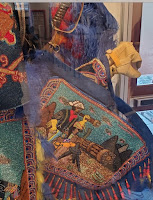There have been no American military engagements in which African Americans have participated at some level. In the 1600s British colonies blacks were used to defend against Indian attacks. Massachusetts’ 1636 law was one of the earliest documented laws to state that “all able-bodied Negroes” had to report to serve in the militia. Enslaved and freedmen were among the 9,000 African Americans serving in the Continental Army as Patriots, largely in integrated units. During the War of 1812 it is estimated that 15% of the soldiers and sailors were of African descent and General Andrew Jackson called for “free colored inhabitants of Louisiana” to enlist in the US Army on Sept. 21, 1814 with the promise of equal pay. The Civil War witnessed Union enlistment of approximately 200,000 African Americans, an estimated 100,000 once enslaved, resulting in a death toll of nearly 40,000.
The government enacted a law on June 28, 1866 that established 4 segregated infantry and two cavalry Buffalo Soldier units. These regiments were created to “increase and fix the military peace establishment of the United States”. They were stationed in the South to enforce Reconstruction, build and repair infrastructure and protect those engaged in the westward migration. The Buffalo Soldiers enlisted for five years at a rate of $13.00 a month and room and board.
In the years they served they were stationed at nearly all of the Texas frontier forts between the Rio Grande and the Red River beginning with their first transfer to Texas in 1873. It was they who erected forts, accompanied wagon trains, guarded the railroads and mail, brought criminals to justice and fought against Indian attacks. They accomplished all these things while being issued substandard equipment and being victims of unrelenting prejudice. Some white officers refused to lead them, Custer being one of them, and they were restricted to postings west of the Mississippi River because some whites refused to have them in their area. In spite of hardships they completed their jobs and served with honor.
The Buffalo Soldiers National Museum and The Center for African American Military History are in Houston, Texas serves to maintain and promulgate their history and legacy. It was established in 2001 by Captain Paul Matthews and meticulously showcases his astonishingly large private collection. Matthews began his collection in the 1960s after learning of their exploits. The 28 galleries are thematic and interpret the history of the Buffalo Soldiers and the African American military experience up to the present. An orientation movie is offered before embarking on the self-guided tour.
Gallery 12 is the Westward Expansion. It is believed that the Buffalo Soldiers received their name from the Plains Indians because their hair and ferocity resembled that of the buffalo. The name was a term of respect and the soldiers themselves embraced it and incorporated the animal on their regimental insignia. Former slave Lt. Henry Ossian Flipper’s story is told here. In 1877 he was the first black West Point graduate and served with the 10th Cavalry as the first black officer to command in the regular US Army. He was targeted, court martialed and dismissed in 1882. In 1999 he received a presidential pardon.
Native Americans, Seminole Indian Scouts and the Indian Wars introduces visitors to the Black Seminole scouts. The Seminoles were asked to relocate to Texas, serve as scouts, and promised, land, rations and pay. They served valiantly but the US kept none of the promises even going so far as to stop rations for their families. The unit was disbanded in 1914 and by that time they had earned Medals of Honor. Four of the honorees are buried in the Seminole Negro Indian Scout Cemetery near Fort Clark, Texas.
President Theodore Roosevelt, after banding together a group known as The Rough Riders, garnered a reputation as a military tactician and leader during the Spanish American War. History tells us that they charged Cuba’s San Juan Hill on July 1, 1898 but somehow omits, or downplays the fact, that all four of the then existing regiments of the US Colored Troops also made the charge. The Rough Riders and the 9th and 10th were the first to charge. Gallery 14 returns them to the narrative.
William Cathay became a Buffalo Soldier on November 15, 1866. Numerous illnesses resulted in visits to the post doctor and the discovery that William Cathay was actually Cathay Williams, the only woman to ever serve as a Buffalo Soldier. She was honorably discharged. A short video and additional information is located in Gallery 15.
The remaining galleries are filled with artifacts, art and memorabilia on the World Wars, Vietnam, Persian Gulf, Pearl Harbor, Women in the Military and the Camp Logan Race Riot. The tour ends at the Medal of Honor Wall with information on the Medal of Honor recipients.
Ultimately the Buffalo Soldiers were deactivated and integrated into a racially integrated US Armed Forces as mandated in Truman’s Executive Order 9981. The Twenty-fourth, the final segregated unit, remained so until the Korean War in 1951.
One of the highlights of the museum is a Buffalo Soldier Mardi Gras costume. It is located in the lobby and one should examine the details closely.
This museum is a gem and not to be missed.
Note: Arlington National Cemetery’s Section 22 features a Buffalo Soldier marker and memorial tree. The Rough Riders Marker is nearby.
www.buffalosoldiermuseum.com
#Buffalosoldiers
#Blackseminoles
#VisitHouston
#HenryFlipper

















Wonderful
ReplyDelete